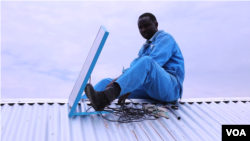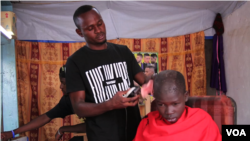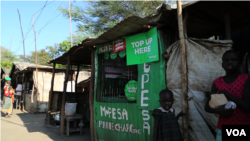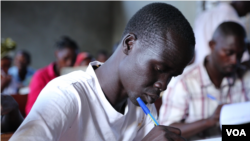Kakuma, Kenya
Jerome Mbusuka fled violence in the Democratic Republic of Congo and found safety in a sprawling refugee camp here in Kenya's northwest corner. He also found work as a barber.
A solar panel provides electricity for the clippers he uses to trim customers' hair. "Without solar, it could have been difficult to do business here in Kakuma," the 23-year-old says.
Mbusuka's purchase of a clean energy source puts him in the vanguard among the camp's 185,000 forcibly displaced residents – and millions in other refugee camps around the world. Few of them have access to dependable electricity. Even fewer can get affordable, efficient energy such as solar.
But Kakuma is generating another kind of power, too: consumer power. The camp and the nearby town for which it's named serve as a laboratory for growing a formal market economy and that depends on access to reliable energy.
At refugee camps, "sustainable energy access (at refugee camps) is not going to be reliant on aid and handout but rather a robust market ecosystem,” said Tijana Radojicic, a senior adviser with the Moving Energy Initiative (MEI).
Radojicic was among the speakers at a town hall held at the Kakuma camp on November 27. At least 150 residents gathered in a big tent for the event, co-sponsored by the Voice of America [[www.voanews.com]] and MEI, to learn more about their prospects and their peers such as Mbusuka.
The Moving Energy Initiative – based at the British policy research institute Chatham House – is an international partnership working to sustainably meet the energy needs of refugees, displaced people and neighboring communities. It’s promoting private sector, clean energy projects in Kenya, Burkina Faso and Jordan.
One partner is the United Nations’ refugee agency. The U.N. has a global goal of improving access to clean, reliable and sustainable energy as part of an effort to alleviate poverty and raise living standards.
Range of challenges
An estimated 1 billion people worldwide, mostly in Africa and Asia, lack access to electricity, the International Energy Agency reports. In sub-Saharan Africa, only four in 10 households have access – a rate that dwindles further in rural areas, according to the World Bank.
In the remote Kakuma town and camp, away from any power grid, just 5 percent of the combined 250,000 residents have electricity. Refugees and displaced people predominantly rely on wood, charcoal and kerosene – fuels that MEI describes as “inefficient, dirty and dangerous.” It estimates 20,000 people a year die prematurely of related respiratory illnesses.
Collecting firewood poses a hazard, too. Susan Mohamed, a panelist and refugee who trains youth in reproductive health issues, said camp residents face hostility from locals competing for scarce fuel. “Some girls are raped in the bush,” she said, “and other boys are beaten and chased away by the host community.”
The Kakuma camp opened in 1992 to shelter people who fled conflict in Sudan, and now includes refugees from South Sudan, Somalia and more than a dozen other countries. Facing work and property restrictions, they depend on aid and some firewood rations. Many also receive remittances from relatives abroad.
"I see myself in a lot of you,” moderator Ayen Bior told audience members at the town hall. The VOA journalist, born in Itang camp in Ethiopia’s Gambella region, lived in refugee camps until age 7 when her family came to the United States. Her family spent a few weeks at Kakuma, where she still has relatives.
Interdependence with host community
The camp lies in the western part of Turkana, Kenya’s poorest county, where four out of five residents live in poverty. But despite some tensions, locals recognize that their economy heavily depends on displaced people and the humanitarian groups that serve them.
Turkana County also is home to Kalobeyei, which opened in 2016 as “the world’s first settlement specifically designed to allow refugees and members of the host community to live and work alongside one another,” as Foreign Policy observed in a recent article.
Kalobeyei is a model to demonstrate “socio-economic cohesion for both refugees and the host community,” UNHCR environment specialist Natalie Ndunda said from the town hall audience.
While poverty exists in both camp and town, so does plenty of commerce. A report last spring by the International Finance Corporation, the World Bank’s investment arm, found an informal camp marketplace humming with at least 2,000 small businesses. These include internet cafes, mobile phone vendors, sellers of produce, goat meat and clothing, and services from bike repair to sewing.
"Frequently, there is this misperception people don’t have access to money,” Andrew Herscowitz, who coordinates the U.S. Agency for International Development’s Power Africa program, said in a video shown at the town hall. “In some cases, that’s true, but if we can tap into limited resources development partners and donor agencies have, and the money people have in their pocket, we can help make everything more efficient, more competitive, so that people can have greater opportunities and greater options."
The challenge is convincing investors that people in displacement communities will pay, even if they have modest means. Kakuma town and camp households’ combined spending tops $56 million a year, the IFC report said. But their per capita household consumption – at $602 and $94, respectively – still trailed the Kenyan average of $800 in 2016.
Pulling together
It takes collaboration to make a market-driven system work in a humanitarian setting.
Radojicic identified the key players as consumers: the private sector, to supply quality products and then to create jobs for selling and maintaining them; financial institutions to provide working capital and to help consumers with the up-front costs of clean energy systems; and policymakers who encourage broad participation in the market.
Development partners and humanitarian agencies should ensure that incentives and bridge financing get provided, Radojivic said. And, she added, they should lead by example, “running their camp management and energy services through solar power.”
A UNHCR clinic in Kakuma camp received solar panels several months ago after health workers said an unreliable power source disrupted medical procedures and spoiled temperature-sensitive vaccines. Since then, the clinic has extended its hours of service and lessened patients’ wait times.
A new MEI report urges humanitarian groups to phase out their use of diesel-run generators and oil, reducing costs and dirty emissions. "The Costs of Fueling Humanitarian Aid" estimates that aid groups spent roughly $1.2 billion last year on such fuels to operate schools, clinics, water pumps and more.
By switching to solar or other green energy, it says, the groups could save roughly $500 million a year.
Looking ahead
UNHCR’s Ndunda said the Kalobeyei settlement is scheduled to get its first mini-power grid to cover households and businesses in a modular plan that could be expanded over time.
“Moving forward,” Ndunda added, “we’re looking to larger-scale investments like a solar farm that would feed into the national grid and be able to provide sustainable and reliable electricity” to all of western Turkana.
Esther Kiyonga, a panelist and a local official in Turkana, said the county was working with government, humanitarian and other partners to “harmonize” economic development.
Kiyonga and other speakers called for more skills training for refugees but also urged them to take more responsibility as paying consumers.
Glada Lahn, a Chatham House senior researcher, echoed that sentiment in a VOA interview.
"In the case of refugees and displaced people, the humanitarian system has tended to see them as beneficiaries of aid, and that’s changing," she said. "There is a need, after you’ve been in a camp for several years … to move away from aid and toward greater self-reliance," she said. "And, you know, in terms of preparing people for when they return to their countries or they settle somewhere permanently, they need to have skills, a means of generating income."
Victor Ndiege, a program manager for the development institution Africa Enterprise Challenge Fund, told the audience to prepare for more investment.
“In the coming one year,” he said, “you will see a lot of financing that will be coming to Kakuma … to ensure that private-sector companies are entering the market. … They recognize now that you are an economic actor and that you are a customer. Make use of that opportunity and ensure that you get quality services.”
Mohammed Yusuf reported from Kakuma, Kenya, with Carol Guensburg reporting and writing from Washington, D.C.
Town Hall Panelists
Ayen Bior
Moderator, international multimedia journalist, VOA South Sudan in Focus Project
Vasco M. Amisi
Operations manager, Resilience Action International
Susan Mohammed
Reproductive health and literacy trainer, Resilience Action International
Tijana Radojicic
Senior energy adviser, Moving Energy Initiative
Victor Ndiege
Program manager, The Africa Enterprise Challenge Fund
Esther Kiyonga
Sub-county administrator, Turkana West, Turkana County Government
Related Links
The Costs of Fueling Humanitarian Aid
Voice of America (VOA) Africa
Voice of America reaches 68 million Africans every week on television, on radio, and online in Afan Oromo, Amharic, Bambara, English, French, Hausa, Kinyarwanda, Kirundi, Lingala, Ndebele, Portuguese, Sango, Shona, Somali, Swahili, Tigrigna, and Wolof. VOA programs are broadcast on over 350 radio, local TV and satellite cable affiliates across sub-Saharan Africa. Africa Division digital media engages daily with audiences about the issues that affect them most, streaming original content on Facebook Live, YouTube, Twitter, WhatsApp, Instagram, and other digital platforms.
voaafrica.com
Moving Energy Initiative (MEI)
The Moving Energy Initiative (MEI) is the first international, multidisciplinary partnership working towards access to clean energy for refugees. Energy 4 Impact, Chatham House, Practical Action, the Norwegian Refugee Council, the Office of the United Nations High Commissioner for Refugees (UNHCR) and the UK Department for International Development (DFID) are the MEI partners. The MEI aims for innovation in policy and practice within the humanitarian sector that can improve access to sustainable energy among displaced populations and camp operators. The MEI is developing, researching and testing sustainable energy solutions and innovative delivery models for heating, cooking, lighting, water and sanitation, communication or other uses.
movingenergy.earth







